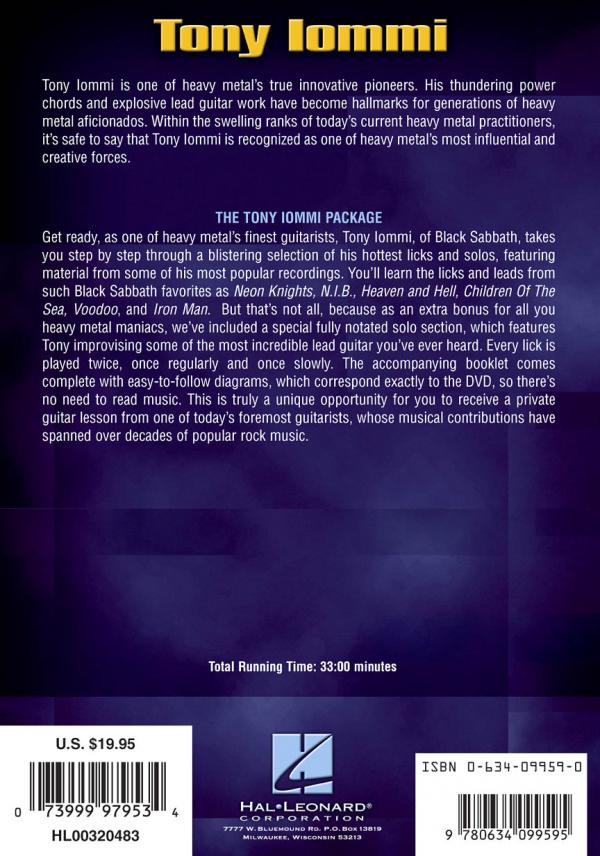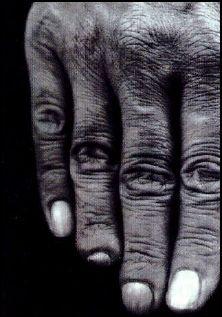IOMMI TONY-MASTER SESSION-BLACK SABBATH-TABLATURE DVD Neon knights-N.I.B.-iron man SPARTITI
IOMMI TONY, MASTER SESSION. TABLATURE DVD
Tony Iommi
Series: Instructional/Guitar/DVD
Format: DVD
Artist: Tony Iommi
One of heavy metal's true innovators, Tony is the guitarist for Black Sabbath. He covers licks and leads from several Black Sabbath favorites, along with a special fully notated solo section. 33 minutes.
Inventory #HL 00320483
ISBN: 9780634099595
UPC: 073999979534
Width: 5.25"
Length: 7.5"
Run Time: 0:33:00
One of heavy metal's true innovators, Tony is the guitarist for Black Sabbath. He covers licks and leads from several Black Sabbath favorites, along with a special fully notated solo section. 33 minutes. Neon knights -N.I.B. -heaven and hell -children of the sea -voodoo -iron man. TABLATURE
Discover the thundering riffs and ear-bending solos of one of metal's true originals, Tony Iommi of Black Sabbath in this unique DVD presented by the man himself!
Learn those great licks, leads and riffs from several Sabbath favourites such as Neon Knights N.I.B. Heaven And Hell, Children of the Sea, Voodoo and Iron Man with a special fully notated solo section.
An accompanying booklet contains diagrams and standard notation to help you learn these blistering and ballsy riffs.
Date Of Birth - 19th February 1948
Place Of Birth - Aston, Birmingham, England
Starsign - Aquarius
Height - 6'2"
Weight - 13.5 stone
Colour Of Hair - BLACK
Colour Of Eyes - Green
Place Of Residence - Warwickshire, England
Cars Owned - Mercedes
Pets - Two Rottweiler Dogs
Hobbies - Cars, Watching Films, Walking
Likes - Having Peace Of Mind
Dislikes - Smoking And Arguing
Favourite Food - Japanese, Indian And Curry
Favorite Drinks - Guinnes, Lager, Vodka and Orange
Favorite Countries - USA & Hawaii for visiting & UK for residing
Favorite Cities - Los Angeles
Favorite TV Programmers - Get Smart & Rockford Files
Favorite Films - The Exorcist and most good horror films
Favorite Actor - Roger Moore and Clint Eastwood
Favorite Actress - No one in particular
Favorite Cars - Ferrari and Lamborghini
Favorite Form Of Travelling - Driving myself otherwise flying
Favorite Sports - Boxing and Wrestling
Favorite Books - Lob San Rampa and Nostradamus
Favorite Animal - Elephant
Favorite DJ's - Alan Freeman and Tommy Vance
Happiest Moments - When I'm getting the communication and feedback from fans at concerts, it's difficult to describe exactly.
Worst Moments - The problems with my ex-management and the divorce from my last wife.
Pet Hates - Getting up too early and having to travel.
If you weren't a Guitarist
what would you have been - Boxer or Wrestler
Early Influences - The Shadows & later on Django Reinhardt
Favorite Bands - Most good 70's bands like Zeppelin, Purple and The Moody Blues etc.
Favorite 80's Bands - No particular Favorites although there are some good ones around
Favorite Guitarists - Brian May, Eddie Van Halen & Joe Pass
Favorite Drummers - Cozy Powell & John Bonham
Favorite Male Singes - Frank Sinatra & Dean Martin
Favorite Female Singers - Anne Wilson of Heart & Barbara Streisand
Favorite Rock Singers - Tony Martin, Ronnie James Dio, Ian Gillan & David Coverdale
Favorite Instrument other
than Guitar - Piano
3 All Time Favorite
SABBATH Songs - HEAVEN AND HELL, BLACK SABBATH and SABBATH BLOODY SABBATH
Favorite Acoustic
SABBATH Song - Laguna Sunrise
Favorite News SABBATH Songs - Devil & Daughter and HEADLESS CROSS
3 All Time Favorite
SABBATH Albums - BLACK SABBATH, SABBATH BLOODY SABBATH and HEAVEN AND HELL
Favorite Own Guitar Solos - Heart Like A Wheel and at the time Lonely Is The Word
Favorite Riffs - Too many to name
Favorite SABBATH Album
Covers - SABBATH BLOODY SABBATH then HEAVEN AND HELL
Worst SABBATH Album Covers - SABOTAGE and BORN AGAIN
Favorite Country to
Perform In - Most Countries
Most Memorable Years for
SABBATH so far - 1973 and 1980
Why - '73 because of the general vibes at the time
and it saw us at a good peak
'80 because it was a new beginning. However,
this excludes the present situation which
is very exciting.
Remaining Goals To Archive - For the band to be back where it should be which is in the top bracket.
Tony Iommi in "BLACK SABBATH Appreciation Society Newsletter Volume 2, 1989".
Tony Iommi's Guitar
In 1996 Iommi : Now I've got an Eggle guitar. It's a different sort of design. I've been in the factory working to get the shape and feel right. It will be called the Iommi Legend. I wanted them to do an SG originally. We came up with more of a contoured and bigger body so it's similar to a Paul Reed Smith, I suppose. I've got my own JD pickups, which are going to be put on the production model as well.
The pickups specially wound for Tony by John Birch were finally duplicated successfully by Gibson
after being approached by Tony at the 1996 International Music Fair (Musik Messe) in Frankfurt.
They are Gibson pick-ups with the "Patent Applied For" decal and were originally available at
Authorized Gibson Dealers for $145.95 USD (I don't know how much they cost now).
The price of the pickups in 1999 range from $189.99 U.S. List to $94.99 U.S. special Sale price, with $145.95 being the average price as stated.
The pickups are fully wax-potted against feedback, have a four-conductor lead for all wiring variations,
have a closed chrome cover, were backed by
Gibson's Limited Lifetime Warranty and 60 day "Guaranteed Gibson Quality" exchange program.
FEB 1999 Gibson to come out with Tony Iommi model SG
TONY IOMMI'S GUITAR COLUMN
Tony Iommi has a regular column in Guitar World, starting with the latest issue, August 1997 (with Foo Fighters on the cover). In the first installment, he explained about his fingers, and then the proper way to play the intro riff to "Paranoid," emphasizing that it is played at the 12th fret, not the 7th.
A BIT OF FINGER
When Tony Iommi used to work in a factory of some kind, his job was to pass
hunks of metal to someone who used a machine to punch holes in the metal
or cut it up or something like that... One day when the other guy didn't
turn up, Tony tried to use the machine and cut the ends off his fingers -
he took the bits to hospital where they said they couldn't do anything for
him. The possibility that he would not ever play guitar again was very real.
Tony may have tried switching to playing right handed, but it wasn't working out.
Then a friend of his gave him a Django Rheinhardt album. This was a gypsy guitarist
who only had two fingers. This inspired Tony to go home and repair his fingers with molten
plastic from an old washing-up liquid bottle, in true Blue Peter spirit.
He had to do so because playing without the ends of his fingers was too painful.
ICE-CREAM ITALIAN JOB
brother and mother were settled. Here he continued to busk until he opened a shop, where he repaired accordions and gave lessons in their playing. Jackie carried on in this business, achieving fame in Birmingham as a first-rate accordionist. He died in 1994. Salvatore Miele’s family followed a similar pattern. Like the Leos he came from Cassino, where he was born in 1891. He was brought over to England with his family about six or seven years later. The Mieles first lived in Barnstaple, from where they “went busking around Devon and Cornwall as work was unattainable”; and later they moved to Birmingham. Pat Houghton, whose father was Francesco Grego (Greco), brought to mind how important the making of icecream was for many of the families.
“My dad wouldn’t impart it to anyone who wasn’t going to go into the business. He used to say, ‘If you gonna do it, I’ll show you how to make it.’ I remember him doing it in the back of Gran’s house. This was a link detached, big, three-storey house with a big yard for his cart and what they called the brew house which he converted for the ice-cream. “It was like a mini dairy and it was subject to health standards. It had sixinch white tiles from floor to ceiling and he did the first boil up in the stainless steel copper. “In the war, instead of butter, dad had unsalted margarine, then the milk and the sugar and the vanilla flavouring or pods. He used to put this mix into the boil to make a custard. “Then with great big pan ladles, like bed warming pans with a concave bottom and no top, he used to put it into stainless steel two-gallon buckets and leave it to stand overnight like egg custard. There’d be muslin cloths over the top to keep out the flies and held down by weights. “Then it was churned. It went into a freezer, a deep cylinder, with long opposing blades. It would churn like butter and outside it was electrically cooled. It turned from a pale yellow into an even paler yellow.
Tinsmith
“He would fetch it into a similar container in an ice-cream cart, packed with ice, and he’d stay out till he sold it. It was the most wonderful ice-cream the world has ever known.” Unlike the Leos and Verechias, the Tavoliers partly moved away from making ice-cream. By the turn of the 20th century they were renting 39 Duddeston Row. This was a confectionery shop as well as their home, as was noted in 1916 in Kelly’s Directory for Birmingham. The publication also recorded an N Barlone as a greengrocer’s in the same street. In Bartholomew Street it went on to mention Lewis Saracine, who was an ice-cream vendor; Mrs Maria Facchino, a shopkeeper; and Antonio Farina, a lodging house keeper. Unlike these people, some other local businesses were not noted in the directory. They included the boot repairer Catullo; the Frezzas and Secondinis who hired out barrel organs and ice-cream carts; and Pip Mattiello the tinsmith.
Nearby in Banbury Street, Frank Iommi made ice-cream and sold it from his house in Buck Street; while Clement Albericci had a small factory, where he “made barrel organs for the Italians and also retuned them and remarked them”. By 1919, Birmingham’s Italian community was concentrated in two streets: Duddeston Row and Bartholomew Street, close to the modern Millennium Point.
Defined
Clement Albericci’s son emphasised that “it was a marvellous atmosphere living in Little Italy, everyone knew each other and helped each other – financially, and reading and writing as some Italians could not read or write.” The members of that Italian Quarter were settled in family groups, most of who came from a defined part of southern Italy. A sizeable proportion of them were self-employed, and the rest were engaged in various occupations. Though small in numbers, these Italians made a significant contribution to the social and economic life of Birmingham and its people. Still, they were distinguished by their names, by their looks, by their language, by their Catholicism, by their dominance of the ice-cream trade, and by their concentration in one area. Iris recalls that the Leos had a close relationship with the Italian families in Birmingham and that they used to go on trips with them to Holywell in Wales, to visit the shrine of St Winefride and bathe in the supposedly healing waters of the well. The Leos and families like them in Wolverhampton and Walsall also made their mark on their towns. If anyone has any memories about other Italian families in the Black Country I’d be keen to hear from you.
Devilish affair of Merry Hell
MR. Norman Robins of Turney Road, Stourbridge, has written to me about the winter of 1947. He informs me that “I was demobilised at the end of February and had come down from Scotland. There had been some snow but the weather was bright and sunny and we were able to get about. “On arriving home in Quarry Bank I found the roads blocked and everything frozen. “Regarding the digging of coal, one night I was in the Fountain Inn in Victoria Road talking to a neighbour who said he was going up to Coppice Lane to get some coal and I could go with him. “We went to a field on the corner of Coppice Lane and Merry Hill, where years ago there had been a pit. There were already several men digging holes. We went to one which had been dug by Mr Fellows, a miner from White City Road. This was a mine pit about 3ft square and left deep coal seams. “The continual frost had frozen the ground right to the bottom. The seam of coal was about two feet thick and very hard. Within a few minutes we had dug out as much as we could carry. “Over the next few weeks I dug out a large amount of coal. “About this time the council employed anyone with a lorry to clear the snow from the roads. It was taken to a field in Mill Street, Brierley Hill. Some of the snow was still there in May. “Today this field is the entrance to the Merry Hill Centre. “As the roads were cleared, cars and lorries came from as far away as Birmingham to buy coal. By now the thaw had set in and some of the holes started to fall in, with several men being trapped. The police came and stopped all digging. “Going back to 1928, when I was five years old, my great grandfather, J T Abbis, would take me with him on his walks and would tell me stories of the area. Unfortunately I only remember one. “We now go back several hundred years. The area of Coppice Lane was lived in by a people who were ruled by the Druid priests. When the people got unruly and wouldn’t do as they were told, the high priest would call a meeting. This took place on the coal site mentioned at dusk. “The priest would threaten them that if they didn’t behave he would cause the devil to bring fire to devour them. While he was talking, some of his priests hiding down the hill were scraping soil from where the coal came to the surface. Oxygen “It was now dark and the high priest would tell them to look down the hill. Smoke would start to appear and the ground would glow, followed by flames. The Priest would send them away telling them to behave in future. After they had gone, the coal seams would be covered over and without oxygen the fires would go out. “This place was named Merry Hell, eventually to become Merry Hill. “Most of the coal seams in this area had been on fire for many years. During the early 1900s, the local council dug out hundreds on tons of red ashes from an area in Pedmore Road, which was used to make footpaths. This area is now a factory estate. Houses have been built on Coppice Lane.
” Idyllic setting for an outing – Antonio Tavolier selling ice-cream at the Lickey Hills from his splendid cart
Italians on a pilgrimage to Holywell, recalled by Iris Hodgkiss, one of the Wolverhampton Leos






